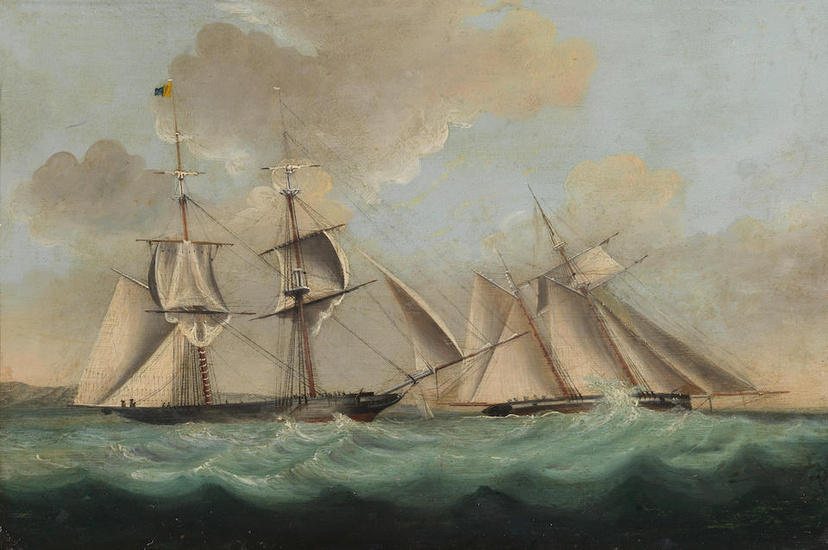Attributed to Nicholas Matthew Condy (British, 1818-1851) The celebrated 1000-Guinea...
Attributed to Nicholas Matthew Condy (British, 1818-1851)
The celebrated 1000-Guinea Match between Lord Belfast's Brig Waterwich and Mr Talbot's Schooner Galatea in September 1834
oil on panel
30.1 x 43.5cm (11 7/8 x 17 1/8in).
The Earl of Belfast, later 3rd Marquess of Donegall, was one of the most colourful personalities in the first decade of British competitive yacht racing. After winning a particularly memorable match in 1831, he famously declared "I have proved to the world that I possess the fastest cutter afloat; I will now see what I can do with a square rigger." Thus were laid the foundations of his flirtations with two square-rigged yachts, the first of which was an outstanding beauty and the second so impressive a sailor that she was coveted by no less an institution that the Royal Navy at the very zenith of its power and prestige.
The first of Lord Belfast's two square-riggers was his little brigantine Emily but the principle legacy of Lord Belfast's 1831 pledge to 'see what he could do with a square rigger' was the creation of the celebrated Waterwich and, as Ian Dear, the yachting historian has stated, "Being the man he was, Lord Belfast did not satisfy himself with any ordinary square-rigger. Instead, he decided to build a ten-gun brig which would out sail the Navy's latest design of this type."
Built by White's at Cowes, the 34-ton Waterwich measured 901/2 feet in length with a 291/2 foot beam and was completed in 1832. Rigged as a brig but designed with the lines of racing thoroughbred, Waterwich joined the Royal Navy's experimental squadron off Cork that autumn for her trials and outsailed everything the navy could field against her. So successful was she that the press demanded she be ought for the fleet but the Admiralty stubbornly refused to take up the challenge. The immediate result was that Waterwich spent most of 1833 outsailing every warship which entered the Solent whilst the Admirality procrastinated and Lord Belfast's patience became exhausted. At the start of the 1834 season, Belfast had her interior refitted as a yacht an in, September, challenged Mr C.R.M Talbot to a race that would clinch Waterwich's reputation. The race, arguably the first ocean contest anywhere in the world and with a prize of 1,000 guineas, was to be over a 224-mile course from the Nab to the Eddystone Lighthouse and back. Talbot's boat, the 190-schooner Galatea got away well and rounded the lighthouse ahead of her rival bit on the return leg, Waterwich overhauled her and won by twenty-five minutes. It was a remarkable victory for a full bodied rig with a square rig and the Admiralty made an instant decision they were not to regret. Bought by the Royal Navy in October 1834, HMS Waterwich retained her name in a fleet and fleet and proved a model of her kind until sold in retirement in 1861.
View it on
Sale price
Estimate
Time, Location
Auction House
Attributed to Nicholas Matthew Condy (British, 1818-1851)
The celebrated 1000-Guinea Match between Lord Belfast's Brig Waterwich and Mr Talbot's Schooner Galatea in September 1834
oil on panel
30.1 x 43.5cm (11 7/8 x 17 1/8in).
The Earl of Belfast, later 3rd Marquess of Donegall, was one of the most colourful personalities in the first decade of British competitive yacht racing. After winning a particularly memorable match in 1831, he famously declared "I have proved to the world that I possess the fastest cutter afloat; I will now see what I can do with a square rigger." Thus were laid the foundations of his flirtations with two square-rigged yachts, the first of which was an outstanding beauty and the second so impressive a sailor that she was coveted by no less an institution that the Royal Navy at the very zenith of its power and prestige.
The first of Lord Belfast's two square-riggers was his little brigantine Emily but the principle legacy of Lord Belfast's 1831 pledge to 'see what he could do with a square rigger' was the creation of the celebrated Waterwich and, as Ian Dear, the yachting historian has stated, "Being the man he was, Lord Belfast did not satisfy himself with any ordinary square-rigger. Instead, he decided to build a ten-gun brig which would out sail the Navy's latest design of this type."
Built by White's at Cowes, the 34-ton Waterwich measured 901/2 feet in length with a 291/2 foot beam and was completed in 1832. Rigged as a brig but designed with the lines of racing thoroughbred, Waterwich joined the Royal Navy's experimental squadron off Cork that autumn for her trials and outsailed everything the navy could field against her. So successful was she that the press demanded she be ought for the fleet but the Admiralty stubbornly refused to take up the challenge. The immediate result was that Waterwich spent most of 1833 outsailing every warship which entered the Solent whilst the Admirality procrastinated and Lord Belfast's patience became exhausted. At the start of the 1834 season, Belfast had her interior refitted as a yacht an in, September, challenged Mr C.R.M Talbot to a race that would clinch Waterwich's reputation. The race, arguably the first ocean contest anywhere in the world and with a prize of 1,000 guineas, was to be over a 224-mile course from the Nab to the Eddystone Lighthouse and back. Talbot's boat, the 190-schooner Galatea got away well and rounded the lighthouse ahead of her rival bit on the return leg, Waterwich overhauled her and won by twenty-five minutes. It was a remarkable victory for a full bodied rig with a square rig and the Admiralty made an instant decision they were not to regret. Bought by the Royal Navy in October 1834, HMS Waterwich retained her name in a fleet and fleet and proved a model of her kind until sold in retirement in 1861.



